
|
The city of Boston, established in 1630, is renowned for its historical significance, culture and colleges, but nowhere in the world is the pride in the local baseball team more apparent.
If ever there were a ballpark worthy of a pilgrimage, it’s nestled into nine acres of land in Boston’s Back Bay. Fenway Park, which was built in 1912 and opened on the same day the Titanic sunk, has earned the phrase “America’s Most Beloved Ballpark,” a moniker the Red Sox now boast of. Over the years Fenway Park has been a constant in baseball, withstanding the test of time for generations of Red Sox fans. It debuted in an era when ballparks were built of wood, stood proud as the cookie-cutter stadiums appeared and disappeared, and continues to glisten in the modern era as other teams try to capture its charm and appeal with their “retro” ballparks. The passion of Red Sox Nation is well known, the history of Fenway Park is unique, and when it comes to going to a ballgame everything about the experience in Boston is to be cherished. Fenway remains one of a handful of ballparks that the majority of fans arrive to by public transportation. Sure, there is some limited parking near the ballpark (for at least $30), but going to the game on the MBTA subway – referred to as the T – is really the only way to go.
One of your first glimpses will be of the neon Citgo sign, which can still be seen from many areas inside the ballpark. A short walk to Brookline Ave. takes you past the Buckminster Hotel – supposedly where the 1919 Black Sox scandal was hatched. Scalpers are plentiful, although they try to ply their trade rather anonymously due to the state’s policy against reselling tickets. Vendors are also in abundance, whether it’s the guys selling Yankees Suck shirts or the stands selling Italian sausages (for $7). There are lots of bars and places to eat prior to the game on Brookline Ave., although long lines exist for most of them, most notably the Boston Beer Works, Pizzeria Uno and the Cask ‘N Flagon, which is directly behind Fenway and located at the intersection of Brookline and Lansdowne Street, which runs parallel to the Green Monster. Although the Red Sox have an official program available inside of Fenway for $4, most fans opt for the popular unofficial program, Boston Baseball, which was founded in 1990 and sells for $2 on the street. It’s also available from a stand in front of the main entrance on Yawkey Way, where there is a large fan plaza accessible only to ticket holders. Yawkey Way is named after Tom Yawkey, the Red Sox owner from 1933-76, and runs parallel to Fenway’s famed brick exterior, which has recently been flanked by Red Sox banners celebrating the team’s pennants and championships. Entering the “little lyrical bandbox of a ballpark,” as John Updike termed it, is sensory overload for the first time visitor. Fenway Park has an omnipresent green; the exact shade a closely held secret by the Red Sox. Most of the seats and walls are painted in this unique hue of green, and then there is the experience of walking up the ramp and getting a first glimpse of what seems to be the greenest grass outside of Ireland. Fenway Park was built to conform to the parcel of land that was allotted to it and the field’s resulting dimensions led to many of the ballpark’s unique features. Most notably, there’s the 37-foot high Green Monster - the most recognized piece of ballpark architecture in the world - which spans 240 feet before giving way to the area known as the triangle in center field.
The Red Sox still operate the famous scoreboard in left field by hand, although it has expanded since 2003 to include all out of town scores and the A.L. East standings, plus a pair of new advertisement panels. Still inscribed in Morse code in two vertical stripes on the scoreboard are the initials TAY and JRY, for longtime owners Tom and Jean Yawkey. The Pesky Pole is in right field, just 302 feet from home plate. But right field is uniquely shaped and it quickly expands to a vast area of grass and warning track a distant 380 feet from home plate. Directly behind the short five-foot right field wall are the bullpens, built in 1940 and known thereafter as Williamsburg. The bullpens were built 23 feet in front of the original right field wall to take advantage of Ted Williams’ powerful pull swing. Another reminder of Ted Williams exists in the right field bleachers where a lone red seat exists among its plastic green counterparts. Located in section 42, row 37, seat 21 – just 13 rows from the top of the ballpark – the seat symbolizes the longest home run ever hit at Fenway Park, a 502-foot blast Teddy Ballgame hit on June 9, 1946. The Red Sox have honored the greatest players ever to wear a Boston uniform on the right field roof façade, where the retired numbers of Bobby Doerr (#1), Joe Cronin (#4), Carl Yastrzemski (#8), Ted Williams (#9), and Carlton Fisk (#27) are displayed. Prior to the arrival of the right field roof tables (192 seats) in 2004, the roof featured a billboard for the Jimmy Fund, the Red Sox’s longtime official charity, which raises money to support the fight against cancer in children. Donation drop boxes for the Jimmy Fund can still be found throughout the concourses inside of Fenway Park. One of the best things about Fenway are the fans that inhabit it. Among their entertaining diversions are beach balls in the bleachers and the playing of Neil Diamond’s “Sweet Caroline” in the middle of the eighth inning, which has become a Fenway tradition. When the Red Sox win fans file out of the ballpark to the tune of the Boston anthem “Dirty Water” by The Standells.
A lot of credit for the record-breaking attendance has to do with the new ownership group led by John Henry. They took control of the team in 2002 and have worked really hard to please fans with ballpark improvements, such as the new seating areas, bigger fan concourses and new signage at the gates. Of course, nothing is more important in Boston than winning, and Red Sox Nation was finally able to rejoice in 2004, as the Red Sox won the World Series to finally put to rest the somewhat legendary Curse of the Bambino. In 2005 baseball fans were able to exult in the announcement that the Red Sox had made a long-term commitment to remain at Fenway Park. The essence of Fenway is something you can’t easily capture in words. Quite simply, it’s baseball nirvana. Thank goodness it will be around for many more years to come.
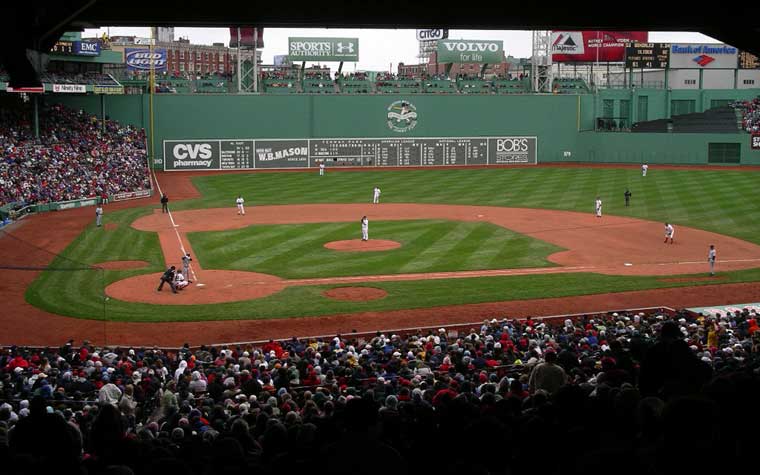
Fenway Park Footnotes - Facts & Figures
| ||||||||||||||||||||||||||||||||||||||||||
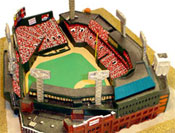
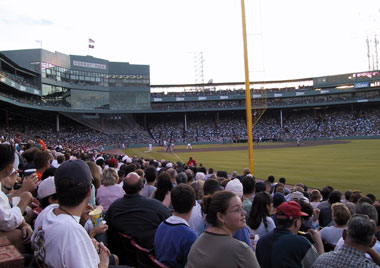
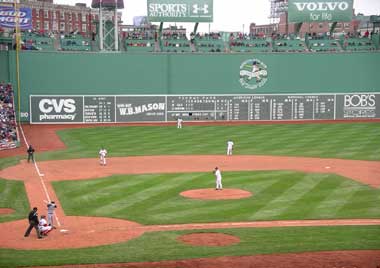
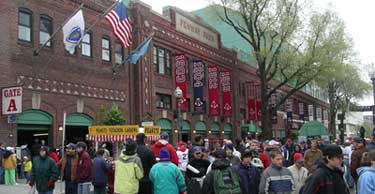 For just $1.25, the T drops Sox fans from all over the city off at the Kenmore Square station. Once you ascend the subway’s steps and walk out onto Commonwealth Ave. you have arrived in the Mecca of the baseball universe.
For just $1.25, the T drops Sox fans from all over the city off at the Kenmore Square station. Once you ascend the subway’s steps and walk out onto Commonwealth Ave. you have arrived in the Mecca of the baseball universe.
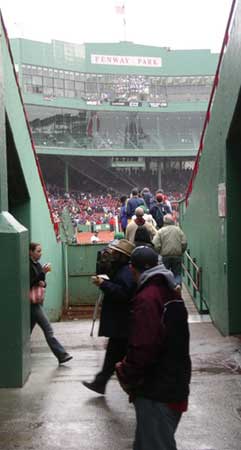 The Green Monster has undergone a major transformation in recent years, capped by the 2003 addition of 274 seats atop it that necessitated the removal of the 23-foot screen that had stood since 1936.
The Green Monster has undergone a major transformation in recent years, capped by the 2003 addition of 274 seats atop it that necessitated the removal of the 23-foot screen that had stood since 1936.


